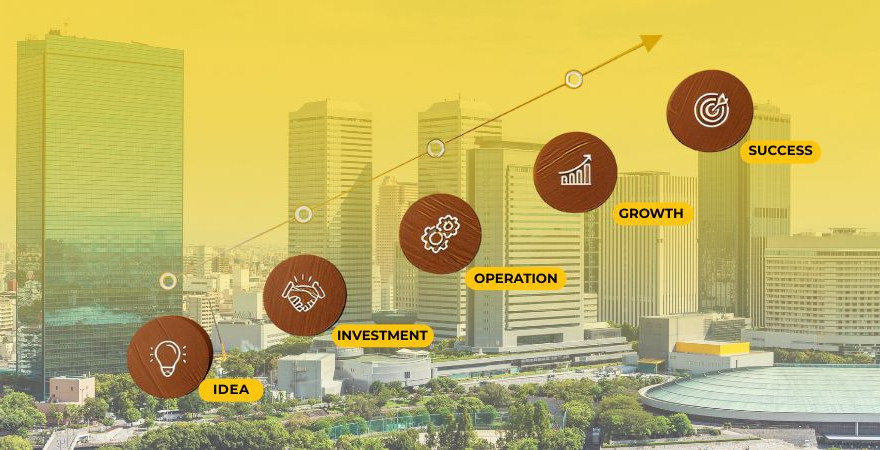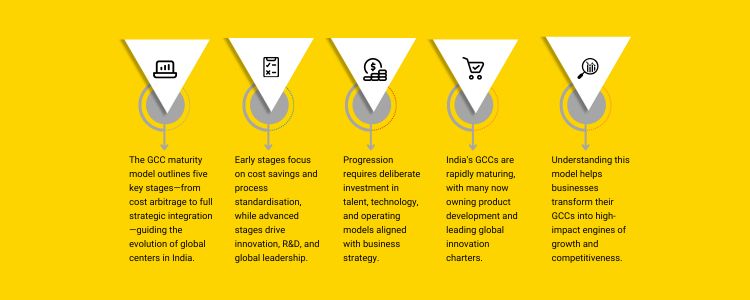
The Global Capability Center (GCC) is no longer a stable, cost-focused unit. They represent a dynamic journey of development, which passes through different stages of maturity to become real strategic assets for global enterprises. It is important to understand the GCC maturity model for any organization before planning to install a global capability center in India. This model designs five major stages, from basic cost arbitration to advanced innovation, and also adds value creation. For the last user, understanding these steps offers a roadmap to optimize the GCC operating model, pursue GCC development, and maximize returns on investment from India GCC. This highlights how an offshore development center can develop into a global captive center from simple function execution that often leads to significant commercial changes under the guidance of special GCC counseling experts. It is not simple to pass through these steps; It requires deliberate strategy, talent, and commitment for investment and continuous improvement in technology. By clearly identifying its current maturity level and future aspirations, an organization can effectively plan its GCC operating model, allocate resources, and promote the culture required to climb a ladder of maturity. This structure helps businesses understand where they are standing on the GCC development path and what steps need to be taken to unlock the entire capacity of India for their efficiency. This structure will help businesses to understand where they are standing on the GCC development path and what steps need to be taken to unlock the entire capacity of India so that they can move beyond efficiency and become a center of strategic innovation and competitive advantage in the global market.
This is the basic phase, where the establishment of GCC is to avail low labor costs and operational efficiency in places like India for the establishment of GCC.
This stage focuses on cost savings and increasing the quality, efficiency, and forecast of the process within GCC.
In this stage, GCC begins to create intensive domain expertise and special abilities, which become a more integral part of the strategic functions of the original organization.
This is a highly mature phase where GCC acts as a true strategic partner, actively innovating in R&D. Puts forward and contributes directly to the development purposes of the original company.
The peak of GCC maturity, where the difference between the GCC and the headquarters becomes blurred. The GCC is fully inherent in the global operating model. Understanding these five stages of the GCC maturity model helps the enterprises to make strategic plans for their journey, ensuring that their India move beyond GCC initial cost savings to become a powerful engine for innovation, development, and permanent competitive advantage in the global market.
The GCC maturity model offers an important roadmap for the enterprise to develop its global capacity centers in India. GCC unlocks significant value, moving from the initial cost contradiction to strategic innovation. Each stage, from focus to global integration, intentionally demands investment in talent, technology, and cultural alignment. Understanding this trip allows organizations to adapt to GCC operating models, to further actual GCC growth, and to convert their India GCC into a strategic powerhouse from an offshore development center. This development, often guided by specialist GCC consultation, ensures that global captive centers actually increase the competitive advantage of a business.
Accelerate Your GCC’s Evolution with the GCC maturity model. Consult Inductus Global. It will help you set up, operate, and grow seamlessly. We align with the parent company’s strategy and vision while maintaining a cultural consistency across both entities. Harness growth opportunities while your center evolves into a center of excellence with our experts by your side. We are committed to our clients and ensure they thrive at the forefront of their industries, today and tomorrow.
The GCC maturity model underlines 5 different stages of development for global capacity centers, including basic cost differences to advanced innovation and uninterrupted global integration. It acts as a roadmap to customize operations and maximize strategic value. Phase 5 represents the global integrated enterprise, where the difference between the GCC and the headquarters becomes blurred. The GCC is entirely inherent in the global operating model, with uninterrupted integration of processes, technology, and culture, which is seen as a source of global leadership and strategic talent. India is the leading destination for GCC, which makes it a primary example to discuss their development. Its huge talent pool, increasing ecosystem, and ability to support all stages of maturity make global capacity centers in India central to understanding this model. When theoretically possible, leaving stages is generally not appropriate. Each stage creates the basic capabilities required for the next stage. The attempt to jump can cause instability, disabilities, and failure to fully feel strategic benefits. The GCC consultation firms provide significant guidance and expertise during the maturity journey. They help to define strategy, select places, ensure compliance, obtain talent, establish operations, and, significantly, plan and implement the transition from one maturity phase to another. Aditi, with a strong background in forensic science and biotechnology, brings an innovative scientific perspective to her work. Her expertise spans research, analytics, and strategic advisory in consulting and GCC environments. She has published numerous research papers and articles. A versatile writer in both technical and creative domains, Aditi excels at translating complex subjects into compelling insights. Which she aligns seamlessly with consulting, advisory domain, and GCC operations. Her ability to bridge science, business, and storytelling positions her as a strategic thinker who can drive data-informed decision-making.
1: Cost Arbitration and Lift-end-Shift
2: Process Adaptation and Standardization
3: Capacity and Domain Expertise
4: Strategic Partners and Innovation Center

5: Global Integrated Enterprise
Conclusion
frequently asked questions (FAQs)

Aditi
Hey, like this? Why not share it with a buddy?
Related Posts
Recent Blog / Post
- The Legal and Compliance Checklist for a New GCC Setup October 4, 2025
- The Rise of Niche GCCs: A Focus on Specialised Capabilities October 4, 2025
- The Impact of Regulatory Changes on GCC Operations October 4, 2025
- Cybersecurity for GCCs: A Proactive Approach to Data Protection September 30, 2025
- Beyond Cost: Measuring the True ROI of Your GCC Investment September 29, 2025
- The Future of GCCs in the Retail Sector: A Strategic Playbook September 29, 2025
- David vs Goliath: Mid-Sized GCCs Quietly Outperform the Big Brands September 29, 2025
- Infineon’s Big Bet on India: Inside Its First GCC in GIFT City September 29, 2025
- From Campuses to Capability Centres: How Indian Universities Power the Global GCC Ecosystem September 29, 2025
- Retail Meets Digital: Costco’s GCC in Hyderabad Marks a Global Shift September 29, 2025
- The Silent Crisis: Why Many GCCs Plateau After 3 Years and How to Avoid It September 24, 2025
- Germany’s New Skilled Immigration Act and Its Ripple Effect on the GCC Talent Model September 24, 2025
- From Tokyo to Hyderabad: The Future of GCCs for Japanese Conglomerates September 23, 2025
- GCCs as AI Acceleration Hubs: Collaborating with US and Nordic Tech Majors September 19, 2025
- Breaking the Tech Ceiling: How Women Leaders Are Reshaping India’s GCC Landscape September 19, 2025
















